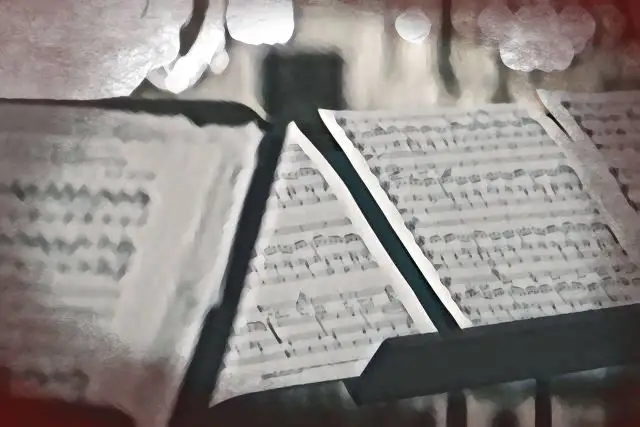Beyond your standard Ionian and Aeolian modes, many consider the Dorian mode to be one of the most important modes in the diatonic scale. Whether you're using it for improvisation or composition, it is a crucial mode to have locked down in your toolkit.
However, we know that modes can be frustratingly mysterious to many musicians starting out (and sometimes for those who have been playing for many years), which is why we're here to take you through everything you need to know about the Dorian mode!
Continue reading to learn more!
What Is A Mode?
Modes, otherwise known as modal scales , are a grouping of seven diatonic scales that are based on the major scale.
You use the major scale of a given key to play each mode, though each mode starts on a different scale degree of the major scale.
So, let's say that you're looking to play the modes of the C major scale. If you were to start on the fifth degree of the C major scale, which is G, you would be playing G Mixolydian .
On the other hand, if you were to start on the second scale degree of C major, which is D, you would be playing D Dorian.
Check out the chart below, which details all of the different modes found in the scale of C major. This same chart can be applied to any major scale.
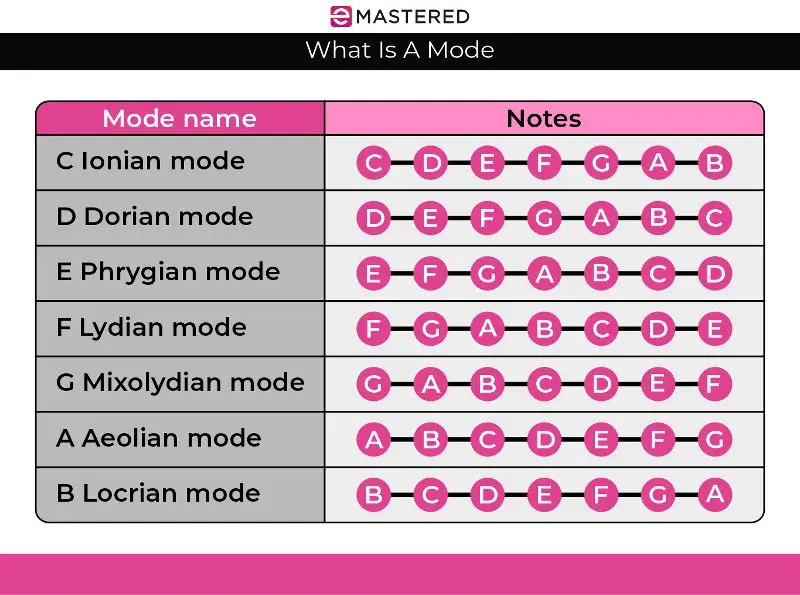
What Is The Dorian Mode?
The Dorian mode is the mode that starts on the second degree of the major scale. If you were to play the Dorian mode in the scale of C major, you would start on D, as D is the second degree of C major.
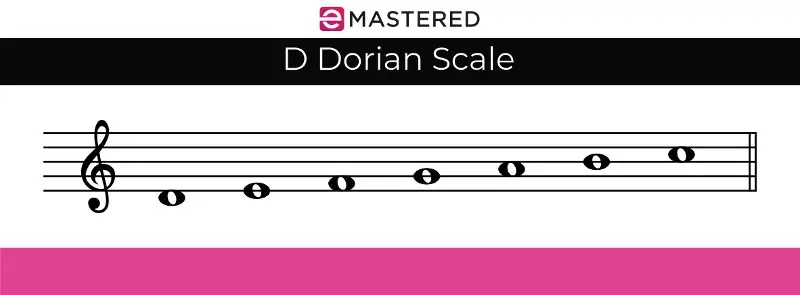
The major scale is composed of whole steps and half steps, so no matter what note you start on, the pattern will remain the same. The pattern looks like this:
W W H W W W H (whole, whole, half, whole, whole, whole, half)
However, since we start on the second degree when using the Dorian mode, we must shift this pattern one step up. It then becomes:
W H W W W H W (whole, half, whole, whole, whole, half, whole)
Dorian Mode Degrees
The Dorian mode is a minor mode, meaning it has many of the same qualities as a minor scale. The third note in the Dorian mode is a semi-tone, which is lowered by a half-step compared to the major scale.
You will also find a seventh that has been flatted.
Overall, the degrees of the Dorian mode look like this:
- Root (1)
- Major Second (2)
- Minor Third (b3)
- Perfect Fourth (4)
- Perfect Fifth (5)
- Major Sixth (6)
- Minor Seventh (b7)
With the flat third and flat seventh, the Dorian mode sounds much darker and sadder than the major scale, which is why people often use the Dorian mode when writing melancholic music. However, because the Dorian mode also has a major sixth involved, it has a unique bright quality to it that you won't find in your typical natural minor or minor pentatonic scale.
Comparing the Major Scale With Dorian Mode
The major scale is at the foundation of all western music and the scale on which we build all of our major modes. The scale consists of seven notes in the whole-half pattern that we talked about earlier.
W W H W W W H
To get a better grasp on the major scale, otherwise known as the diatonic scale, you can take a look at the chart below:
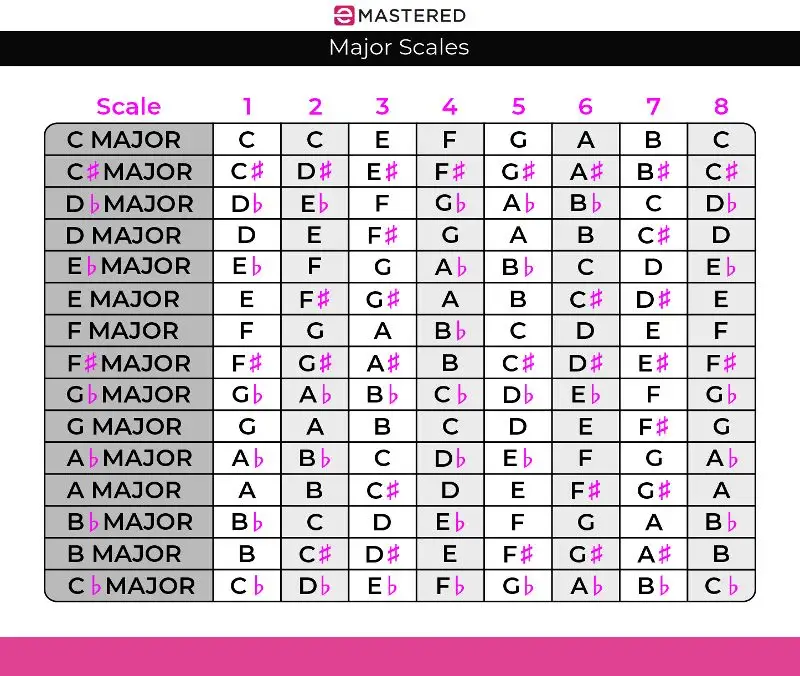
We derive the Dorian mode from the major scale, which is the Ionian mode. However, for example, if we were to use the C major scale, we would start on the second degree, D, to get the Dorian scale.
However, though both of these scales share all of the same notes, there are some pretty clear changes that pop up.
It's important to note that when the starting note of a scale changes, so does its tonal center, which then affects the intervals found in the scale. For that reason, the Dorian scale has a much different feel than its major counterpart.
If you were to improvise on the piano using only the white notes on top of note D, it would sound very different than if you were to do so using note C.
In D Dorian mode, you'll find a minor third between the first and third scale degrees, which is what gives this mode its minor quality compared to C major. In C major, otherwise known as Ionian mode, the interval between the first and third scale degrees is a major third.
Comparing the Natural Minor Scale With Dorian Mode
The natural minor scale sometimes referred to as the Aeolian mode, is similar to the Dorian mode in that both of these are considered minor scales. This is because the interval between the root note and the third note is a minor third.
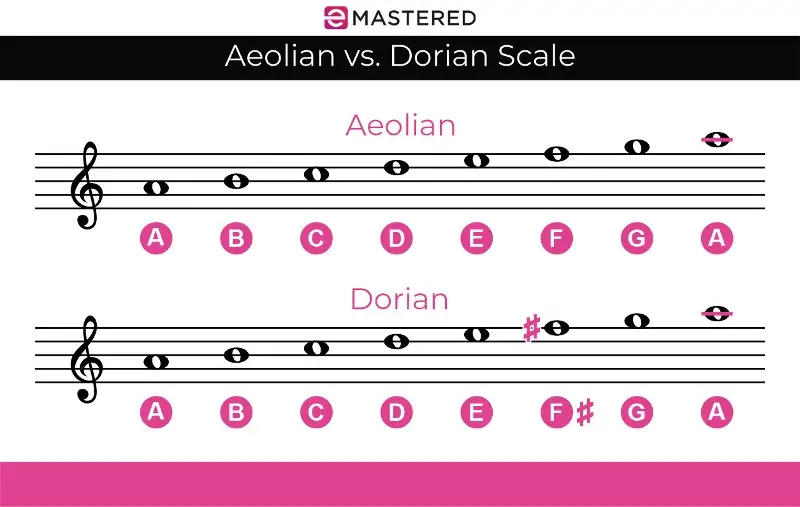
If you look at the image above, you'll notice that the major sixth interval in the A Dorian mode is the one thing that truly sets it apart from the A Aeolian mode. This major sixth interval between A and F# gives the Dorian scale a different whole-half step sequence.
If you were to play both of these scales on the piano, you would immediately notice the bright quality compared to the Dorian scale compared to the minor scale, which we talked about earlier.
How to Find The Notes in The Dorian Scale
At this point, you should have a decent understanding of the Dorian scale. The good thing is that finding Dorian scales relative to their major scales is quite simple, as Doring is only a step up.
Of course, it's still crucial that you know how to approach the notes in the Dorian mode with a modal mindset.
If you're looking for the notes in a Dorian scale, whether C Dorian, B Dorian, Eb Dorian, or any other type of Dorian, you can use one of the techniques below.
Technique #1 - The Modal Formula
The modal formula is one of our favorite ways to figure out the notes in modes.
The modal formula for the Dorian scale is:
2 3 4 5 6 7 1
You'll start by choosing a note to build your mode on top of. For this example, let's switch it up and start with the note B.
The root note in Bb Major is Bb. However, since we start on the second degree when building on top of Dorian, we'll use the second note in Bb major as the first note in the Dorian scale, which is C. So, for this example, we'll be in C Dorian.
The notes of C Dorian are the same as in Bb major, though starting on note C, they look like this:
C-D-Eb-F-G-A-Bb
Technique #2 - Use the Relevant Major
Technique #2 can be really helpful if you're ever jamming in a band or soloing live and you need to find the right notes.
The beauty of modes is that they are all based on major scales. So, for Dorian (and all other modes), all you have to do is find the relevant major that it is based on. The relevant major for a Dorian mode will ALWAYS be two half-steps or one whole-step below the root note of that major.
For example, if you were performing in a band setting and someone shouted out, "play in B Dorian," you would know to think one whole step down to A major. Then, instead of having to remember all of the notes in B Dorian, you could just remember all of the notes in A major and keep in mind that was your tonal center.
We love this technique for those who are just starting out and have only memorized their major and minor scales.
Dorian Mode Characteristics
When we talk about a mode's characteristics, we're talking about the defining qualities that separate it from other tones. These are the elements that give a mode its unique flavor.
We always recommend looking at where the half-step intervals and tritones exist when trying to gauge the quality of a mode. You can also look at the quality of the third to determine whether it is major or minor.
The major scale's modes use two half-steps and a single trione interval, which can go both ways. For example, in the key of C, B to F is one tritone, while F to B on the way down is also a tritone.
The Dorian tritone exists between the minor 3rd and major 6th intervals, while the half-steps exist between the major 6th and minor 7th, and major 2nd and minor 3rd.
With the minor 3rd, we can gauge that Dorian has a minor quality about it, very similar to the natural minor. Of course, as we said before, it's the raised 6th that distinguishes it from all of the other modes, as well as the natural minor and minor pentatonic scale.
Popular Songs Using The Dorian Mode
Wicked Game - Chris Isaak
We often find the use of Dorian mode by looking at the chord progression in a song and how it fits with the melody. When you listen to a lot of classical music that only uses instrumentation, you get an idea of modality based on the instrumentation that you find playing underneath the key.
However, in most modern music, the instrumental often lacks modality. It isn't until the vocal is added to the music that it becomes clear what mode you are using.
While a vocal melody will often end on the tonic or root of the major or minor scale, a vocal melody that ends on a different note other than the tonic signifies that it is probably part of another mode.
In the case of Chris Isaak's "Wicked Game," the vocal melody ends on the second degree of what would otherwise be the major scale. For this reason, we can assume it is in Dorian mode.
Billie Jean - Michael Jackson
"Billie Jean" is a hit single produced by Quincy Jones and the late Michael Jackson. The entire structure of the verse is deeply in E Dorian mode, as the vocal melody ends on an F#, which is the second degree of the key of E Major.
While some may argue that the song is actually in Aeolian, we believe that the D# in the G#m chord in the song solidifies its Dorian flavor.
Mad World - Tears for Fears
"Mad World" by Tears for Fears is a popular song that screams Dorian mode. Every section of this fantastic piece of music is written in A Dorian. You can look at the following chord changes to see Dorian mode in action:
- Verses & Instrumental - Am-C-G-D
- Choruses - Am-D
- Refrain - Am C D
List of Dorian Scales
Below, you will find a chart that lists all of the Dorian mode scales starting from all different notes.
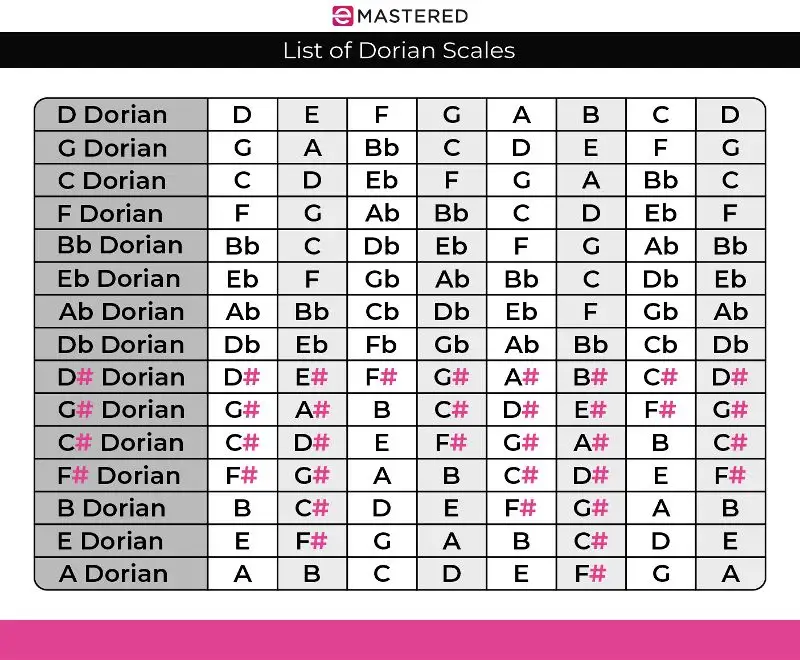
Putting The Dorian Scale To Use
To start putting the Dorian mode to use, you'll want to learn the mode inside-out. Start by ensuring that you have all of the notes memorized and familiarize yourself with playing the Dorian mode in ascending and descending form.
Ensure that you can play it in any of the relevant major keys.
Here are a few ways we recommend integrating the Dorian scale into your practice and playing:
Playing Scales
Start by learning how to play to the Dorian scale in ascending and descending order. We recommend starting with D Dorian, as it is the easiest to play of the bunch. Then, you can move to C Dorian, B Dorian, E Dorian, and all of the other Dorian modes.
Soon, you'll begin recognizing the pattern of tones and semi-tones or whole and half-steps, which will allow you to easily transpose this scale into any key of your choosing.
Familiarize Yourself With Scale Interval Patterns
After you feel comfortable playing scales, you'll want to begin practicing intervals. Again, the Dorian mode consists of these intervals:
- Major 2nd
- Minor 3rd
- Perfect 4th
- Perfect 5th
- Major 6th
- Minor 7th
As you play these intervals, think about the kind of mood they give off and do your best to internalize it for future reference.
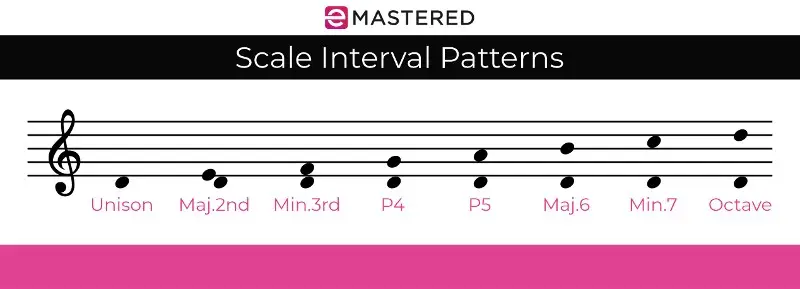
When you feel tuned in to what these intervals sound like, and you feel comfortable enough playing scale patterns, you can expand your playing repertoire, experimenting with melodic and intervallic note patterns while sticking to your tonal center.
Experiment With Triads and "Dorian" Chords
Playing cluster chords that are built on the notes of the Dorian scale is a great way to internalize how the mode feels. For example, you can use the characteristic flat thirds and seventh to make minor seven chords or minor triads.
To add a bit more interest to your chords, you can even use the unique major 6th degree found in the Dorian scale.
Look at the photo below for some good examples of Dorian chords:
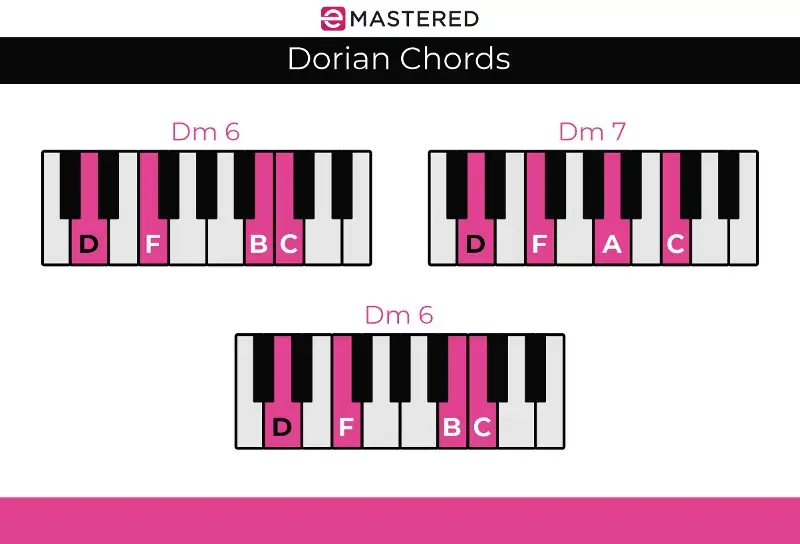
Put Your Practice To Good Use
Using backing tracks or your favorite Dorian scale songs, you can use your knowledge of the Dorian scale to improvise atop the Dorian mode. Exploit the unique characteristics of the Dorian scales, such as the major 6th interval, play using minor chords, or focus on the relationships between the intervals.
Here is a good Dorian scale backing track to get you started:
Final Thoughts
Beyond the Ionian and Aeolian modes, the Dorian mode is the simplest of the modes to get a grasp on. Because it is so similar to the standard minor scales, it will likely sound and feel very familiar. Plus, with the use of these distinctive intervals that the Dorian scale uses, it's easy to play and improvise without worrying that what you're playing will feel dissonant.
As you start using the Dorian scale in your music, there are a few things to look out for that I want to leave you with:
- When playing, always remember where your tonal center is. Though Dorian modes are based on relative majors, the last thing you want is for someone listening to your music to lose your tonal center because you keep landing on the major's tonal center instead of the modal tonal center.
- Utilize the half-bright and half-dark characteristics. The Dorian mode is one of the only seven modes that have a mixture of brightness (using the major sixth) and darkness (using the major third). We recommend highlighting these notes as you play, as they can be helpful in creating unique ebbs and flows in your music.


